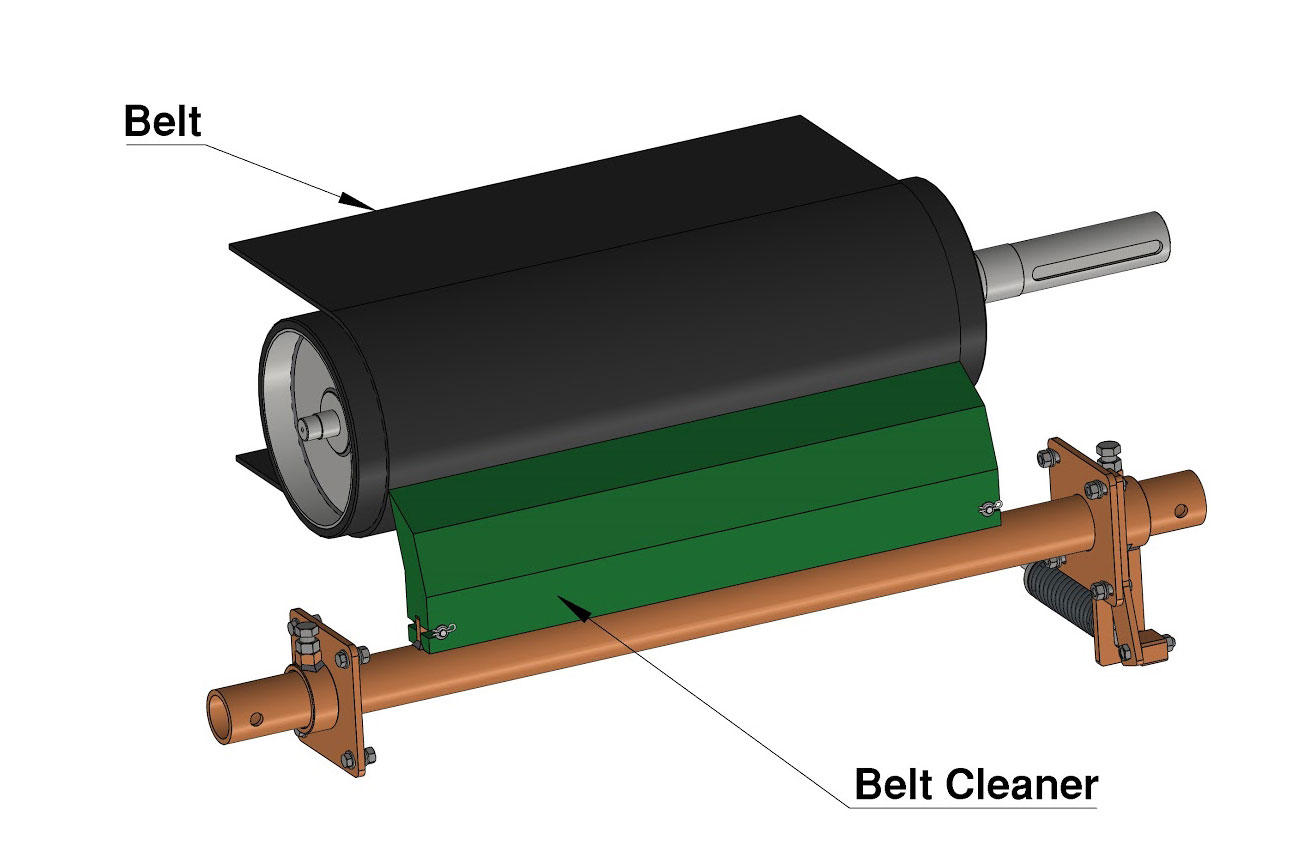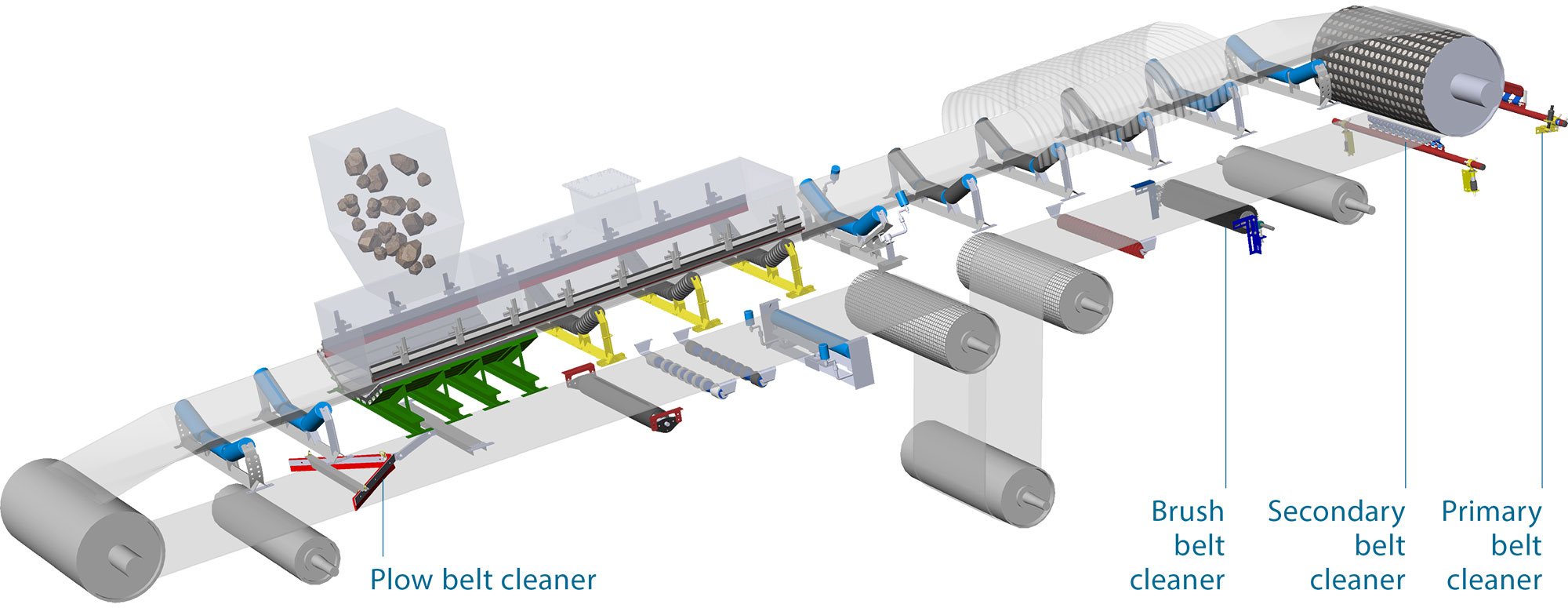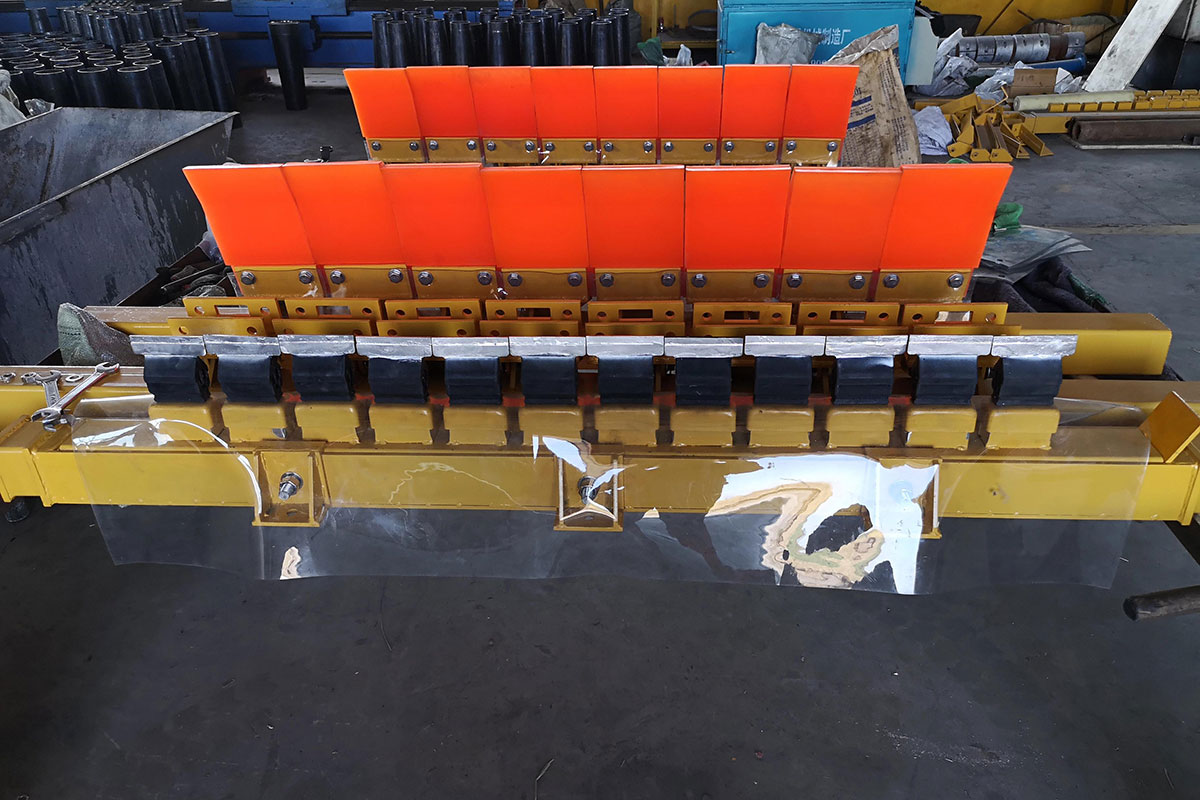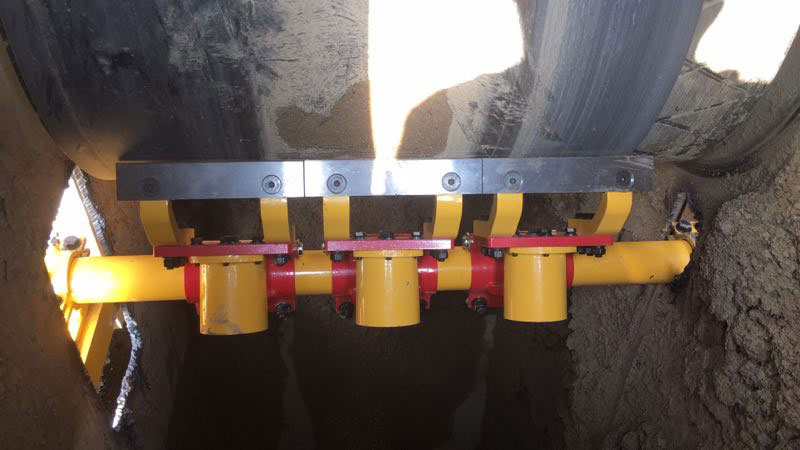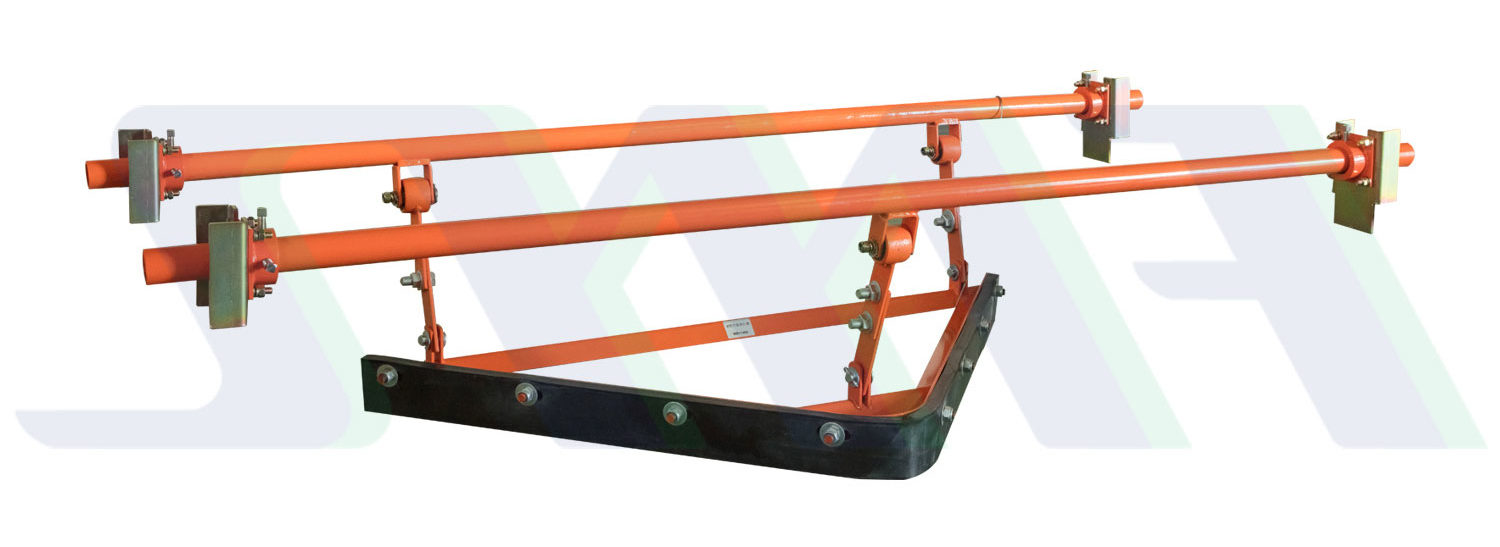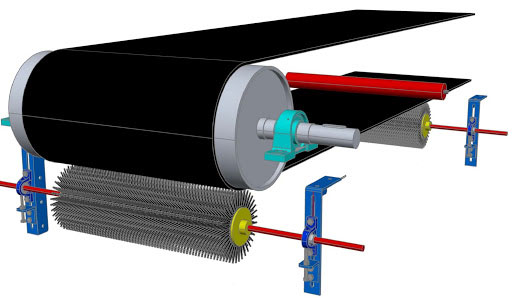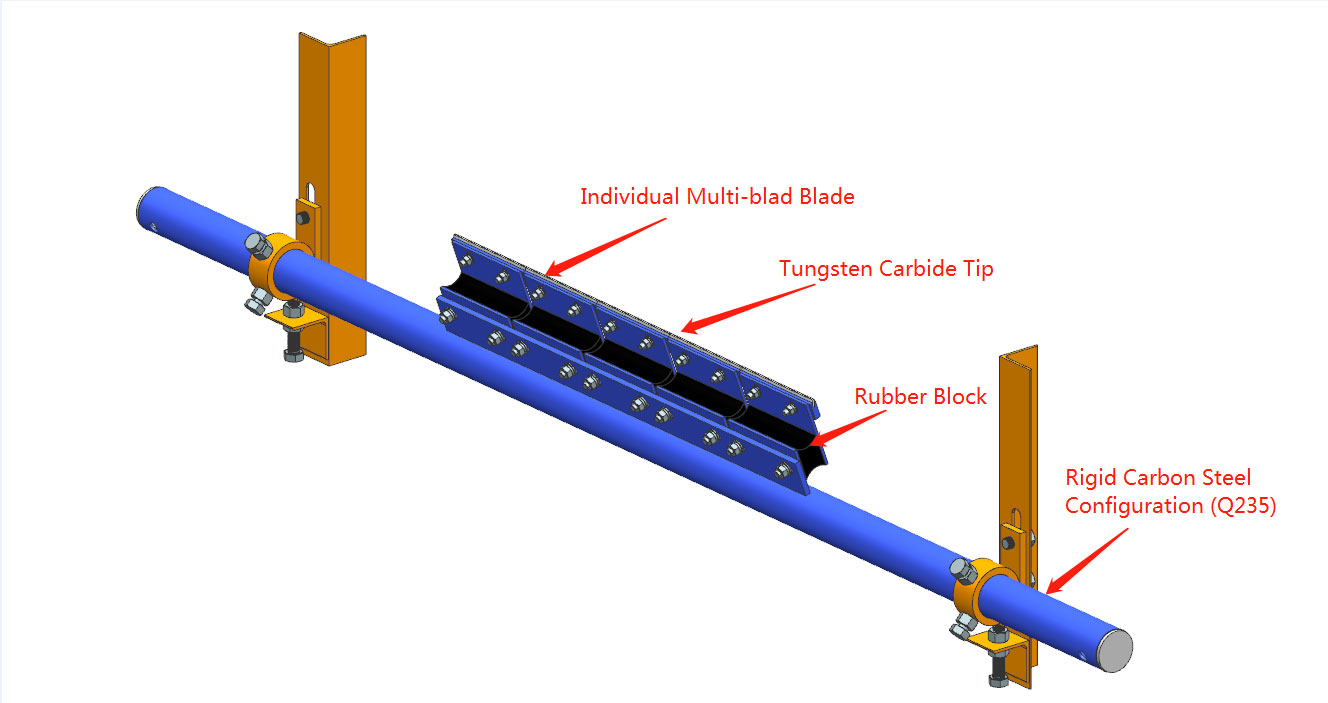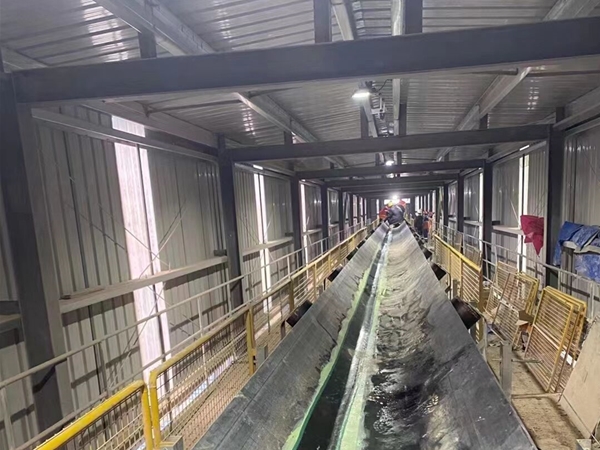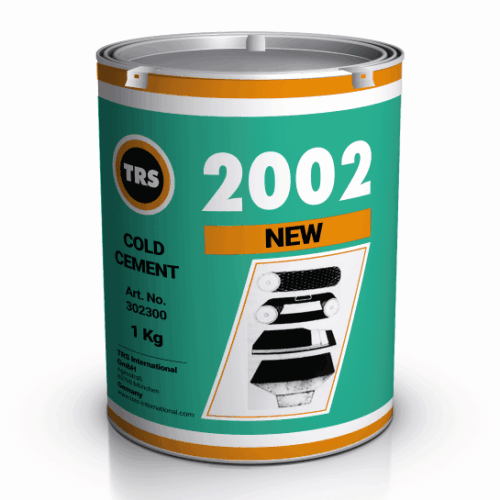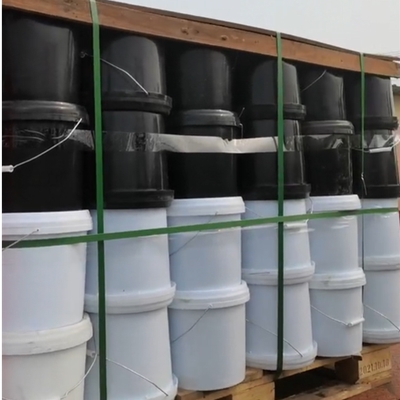A conveyor belt cleaner is often called a conveyor belt scraper, it can remove sticky material from the conveyor belt and keep it as clean as possible. A high-performing conveyor belt cleaner can keep belts clean, eliminating carryback and making conveyor systems safer and more productive.
1. Common Problems for Conveyor Belt Cleaning
The conveyor belt materials may have sticky substances, such as coal dust, mud, and powdery materials. Some of them will stick to the working surface of the conveyor belt and cannot be completely removed during unloading. As the belt runs, it will stick to the roller, and it will bring many problems for the belt conveyor.
a. The material enters the shell of the roller, which increases bearing wear. The material attached to the shell of the roller will damage the surface glue of the conveyor belt and accelerate the damage of the conveyor belt.
b. The adhesive material enters the tail wheel and changes to the roller, and it will stick to the surface of the roller. More and more sticky materials cause the deviation of the conveyor belt, aggravating the wear of the conveyor belt.
c. The material sticks to the driving roller and increases its friction, which will cause damage to the surface glue of the conveyor belt and the coating layer of the pulley lagging.
d. Without cleaning in time, they will form a blanking area in the whole work channel. It not only causes environmental pollution but also increases the cleaning workload.
2. How it Works for Conveyor Belt Cleaner
A conveyor belt cleaner is mainly used in the head and tail of the belt conveyor. The head belt cleaner is used to scrape the sticky materials and debris on the front of the belt. The tail belt cleaner is used to scrape the accumulated materials and debris on the back of the belt to prevent them from entering the roller.
The scraper of the belt cleaner has large stretchability. When the belt is worn unevenly by the conveyed materials, it can be changed according to the belt shape on the head wheel, and the belt on the head wheel is irregularly rotated to make a close match to produce a complete scraping effect.
Its spring tension regulator has the functions of automatic compensation and shock absorption, maintaining a fixed contact pressure and increasing the life of the scraper. The moulded design allows the blade assembly to be fixed without screws, which makes maintenance and replacement easy and maintains the straightness of the blade tip.
The belt cleaner has a simple structure and relies on the friction between the passive roller and the belt. Without power supply and control devices, it can save materials. The rotation direction of the cleaning roller brush is opposite to the direction of movement of the return belt, which makes the attachments on the lower surface of the return belt are bounced off to achieve the purpose of perfect cleaning.
3. Conveyor Belt Cleaner Types
According to different installation positions, conveyor belt cleaners are divided into primary belt cleaners, secondary belt cleaners, and empty section cleaners. A primary cleaner is also called a pre-cleaner, it is installed at the discharge roller. The secondary belt cleaner is installed on the stable working surface near the head wheel. The empty section cleaner is located at the front end of the redirecting roller.
Common conveyor belt cleaner includes heavy hammer cleaners, spring cleaners, alloy rubber cleaners, rotating brush cleaners, cleaning rollers, PUR polyurethane belt cleaners, enclosed cleaners, Carbide scraper cleaner, electric roller brush cleaner, electric vacuum cleaner, rotary cleaner, etc. Here are several commonly used conveyor belt cleaners:
1)PUR Polyurethane Belt Cleaners
The PUR polyurethane belt cleaner is installed at the driving roller of the belt conveyor. Its scraper is made of polyurethane composite material, which is formed by a mold. The scraper has a flat surface, good straightness, low friction, high wear resistance, and high strength. It has a fairly stable scraping effect, which can effectively remove fine particles and wet sticky materials remaining on the belt. The pre-pressure regulator ensures a stable contact pressure between the scraper and the belt.
Features:
- The scraper can generally be used for 1 to 3 years and will not damage the belt;
- The use of polymer polyurethane, coupled with better comprehensive mechanical properties, prolongs the product life cycle;
- Compact design structure, reasonable preparation, the product is light, beautiful, and easy to operate;
- The spare parts are interchangeable and adjustable, making it easier to install, debug, replace and maintain
2)Carbide scraper cleaner
The alloy conveyor belt cleaner mainly cleans small particles and their media, and the transported materials can be cleaned even if the humidity is above 5%. The cemented carbide scraper cleaner is installed on the head of the belt conveyor. The scraper is made of cemented carbide., which includes two types of single and double plates. The pressure of the scraper can be changed by adjusting the counterweight to achieve the thoroughness effect of cleaning materials.
Features:
- Novel Structure: unique buffer compensation device brings good anti-shock and vibration performance for the conveyor belt, it has a good cleaning effect, and not easy to damage the conveyor belt.
- Equipped with a high-function standard component system, including system support pipes, support pipe extensions, and elastic buffer devices. The adjustment mechanism facilitates the adjustment of the contact pressure between the scraper and the conveyor belt and adjusts the direction of the metal scrapers on both sides after the scraper is worn. The outer shape is a descending arc, which effectively prevents the edge of the scraper from damaging the smooth PE knife plate guard on the belt surface, and can prevent material accumulation and scaling
3)Non-Loaded Conveyor Belt Cleaner
The non-loaded cleaner adopts a rubber plate or wear-resistant liner as the cleaning plate. It can be installed on the return branch of the conveyor belt, on the upper side of the conveyor belt, near the tail roller, or pulled vertically.
In order to reduce the wear of the cleaning plate, springs are often used to automatically adjust the contact between the cleaning plate and the conveyor belt to ensure the quality of cleaning.
4)Rotary Brush Conveyor Belt Cleaner
The rotary brush cleaner is a new type of product, which can effectively clean the surface of the roller and the adhesion on the bottom surface of the conveyor belt. It is composed of a motor, a reducer, a cleaning drum, a coupling, a bearing seat, and an adjusting frame.
It is driven by a motor to drive a cylindrical nylon brush, the brush tip is slightly in contact with the belt surface. The rotating direction of the nylon brush is opposite to the running direction of the return conveyor belt so that the particulate material stuck on the belt surface is brushed down to achieve the purpose of thorough cleaning.
It is widely used in industries such as coal plants, chemical industry, sugar-making, pharmaceuticals, ports, and wharves.
Features:
- Integrated design: easy installation and adjustment, strong applicability
- Will not cause tape deviation during cleaning
- Safe and reliable, long service life, low maintenance cost
- When the cleaner is working, the cleaning points are in continuous contact, it brings a powerful cleaning and great cleaning effect
- Nylon brushes are processed by a special process, which is non-sticky and non-scaling
- No wear to the tape, prolonging the service life of the tape
5)Alloy Rubber Cleaner
The alloy rubber cleaner is installed on the roller head. It mainly relies on the elastic force of the rubber rod, and the scraper material is changed from rubber to cemented carbide. After the material and the conveyor belt are separated, the scraper close to the surface of the conveyor belt and clean materials.
The alloy rubber cleaner is mainly composed of multiple alloy scrapers, scraper frames, rubber elastic bodies, beams, adjustable fixing frames, etc. With a simple and compact structure, the scraper and the drive roller can be adjusted by adjusting the fixing frame. Then turn the beam shaft to make the contact pressure between the scraper and the driving roller reach 100-150N, and then lock the bolt.
The materials cleaned by the alloy rubber cleaner will directly fall into the head cone of the continuous conveyor and be transported together with other materials. It will totally solve the problem of material accumulation.
4. How to select a suitable conveyor belt cleaner
The biggest problem of conveyor belt cleaner is the poor cleaning effect, there are 3 reasons for this problem.
a. Wrong selection of conveyor belt cleaner.
b. The installation position of the cleaner is wrong.
c. The blade of the cleaner is not wear-resistant.
To avoid this problem, we should choose the right conveyor belt cleaner. Before you purchase your conveyor belt cleaner, make sure you have collected all the following information about your belt conveyor.
- The installation location and its chute structure
- The position of the conveyor belt and the conveyor frame, and the position of the pressure roller
- Conveyor belt speed and various surface conditions and quality
- Connector type and whether it is a two-way running conveyor belt
- Type and characteristics of conveying materials, water content, particle size, and viscosity of materials
Providing the information to your conveyor belt scrapers manufacturers, they will select the best conveyor belt scrapers for your belt conveyor.
In general, the conveyor belt cleaner manufacturer will choose the belt scrapers according to the following rules:
- Fix the size of the conveyor belt cleaner according to the bandwidth, belt speed, and transportation volume of the conveyor
- Select different types of conveyor belt cleaners according to the characteristics of the material being transported and the actual situation of the conveyor belt
- According to the joint type of the conveyor belt, select a safe and reliable conveyor belt cleaner structure
- According to the wear of the conveyor belt, choose conveyor belt cleaners with different cleaning methods.
- According to the running direction of the conveyor belt, choose whether the working model of the conveyor belt cleaner is reversible.
- According to the size of the installation space, fix the installation method and tightening method of the conveyor belt cleaner.
The conveyor belt cleaner is an important part of the belt conveyor, and its working effect directly affects the performance, status, and service life of the belt conveyor. Choosing a suitable set of conveyor belt cleaner will not only make the belt conveyor work smoothly and reliably, but also extend the service life of the belt conveyor

